Centauri Dreams
Imagining and Planning Interstellar Exploration
Voyager: Pressure at the Edge of the System
One of these days we’ll have a spacecraft on a dedicated mission into the interstellar medium, carrying an instrument package explicitly designed to study what lies beyond the heliosphere. For now, of course, we rely on the Voyagers, both of which move through this realm, with Voyager 1 having exited the heliosphere in August of 2012 and Voyager 2, on a much different trajectory, making the crossing in late 2018. Data from both spacecraft are filling in our knowledge of the heliosheath, where the solar wind is roiled by the interstellar medium.
A new study of this transitional region has just appeared, led by Jamie Rankin (Princeton University), using comparative data from the time when Voyager 2 was still in the heliosheath and Voyager 1 had already moved into interstellar space. Leaving the heliosheath, the pressure of the Sun’s solar wind is affected by particles from other stars, and the magnetic influence of our star effectively ends. What the scientists found is that the combined pressure of plasma, magnetic fields, ions, electrons and cosmic rays is greater than expected at the boundary.
“In adding up the pieces known from previous studies, we found our new value is still larger than what’s been measured so far,” said Rankin. “It says that there are some other parts to the pressure that aren’t being considered right now that could contribute.”
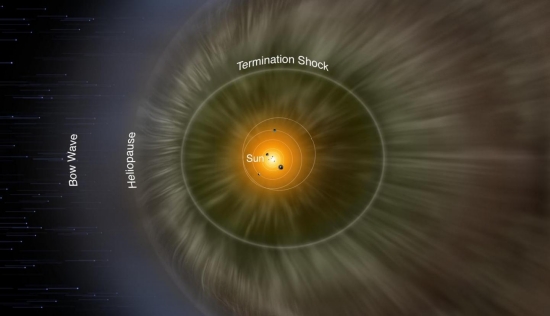
Image: This is an illustration depicting the layers of the heliosphere. Credit: NASA/IBEX/Adler Planetarium.
Thus the Voyager data continue to be robust, giving us a look into a dynamic and turbulent region through which future missions will have to pass. The particular area that the study’s authors focused on is called a global merged interaction region, a wave of outrushing plasma produced by bursts of particles from the Sun in events like coronal mass ejections. Such an event is visible in Voyager 2 data from 2012, causing a decrease in the number of galactic cosmic rays, one that Voyager 1 would go on to detect four months later.
Traveling at nearly the speed of light, galactic cosmic rays are atomic nuclei from which all of the surrounding electrons have been stripped away. The difference between how this change in their numbers was detected by the two spacecraft is instructive. Still within the heliosheath at the time, Voyager 2 saw a decrease of galactic cosmic rays in all directions around the spacecraft, whereas at Voyager 1’s vantage beyond the heliosphere, only those galactic cosmic rays traveling perpendicular to the magnetic fields in the region decreased.
This intriguing asymmetry flags the crossing of the heliosheath, though the study’s authors are quick to point out that why this directional change in cosmic rays occurs remains unknown. They are able to calculate the larger than expected total pressure in the heliosheath, and discover that the speed of sound in the heliosheath is roughly 300 kilometers per second (remember that the speed of sound in any medium is simply the speed at which disturbances in pressure propagate, in this case the result of interactions in the solar wind).
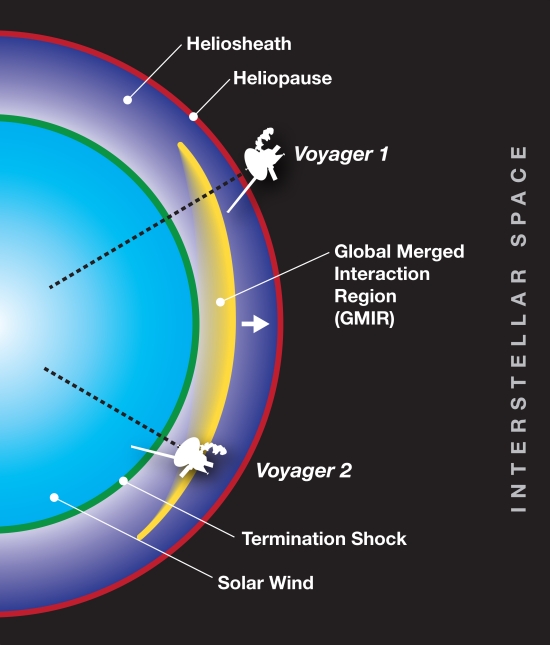
Image: The Voyager spacecraft, one in the heliosheath and the other just beyond in interstellar space, took measurements as a solar event known as a global merged interaction region passed by each spacecraft four months apart. These measurements allowed scientists to calculate the total pressure in the heliosheath, as well as the speed of sound in the region. Credit: NASA’s Goddard Space Flight Center/Mary Pat Hrybyk-Keith.
“There was really unique timing for this event because we saw it right after Voyager 1 crossed into the local interstellar space,” Rankin said. “And while this is the first event that Voyager saw, there are more in the data that we can continue to look at to see how things in the heliosheath and interstellar space are changing over time.”
The paper is Rankin et al., “Heliosheath Properties Measured from a Voyager 2 to Voyager 1 Transient,” Astrophysical Journal Vol. 883, No. 1 (25 September 2019). Abstract.

Enceladus: New Organic Compounds via Cassini Data
While I’m working on the project I discussed the other day, I’m trying to keep my hand in with the occasional article here, looking forward to when I can get back to a more regular schedule. Things are going to remain sporadic for a bit longer this month, and then again in mid-November, but I’ll do my best to follow events and report in when I can. I did want to take the opportunity to use an all too brief break to get to the Enceladus news, which has been receiving attention from the space media and, to an extent, the more general outlets.
We always track Enceladus news with interest given those remarkable geysers associated with its south pole, and now we return to the Cassini data pool, which should be producing robust research papers for many years. In this case, Nozair Khawaja (University of Berlin) and colleagues have tapped data from the spacecraft’s Cosmic Dust Analyzer (CDA) to study the ice grains Enceladus emits into Saturn’s E ring, finding nitrogen- and oxygen-bearing compounds. These are similar to compounds found on Earth that can produce amino acids. Says Khawaja:
“If the conditions are right, these molecules coming from the deep ocean of Enceladus could be on the same reaction pathway as we see here on Earth. We don’t yet know if amino acids are needed for life beyond Earth, but finding the molecules that form amino acids is an important piece of the puzzle.”
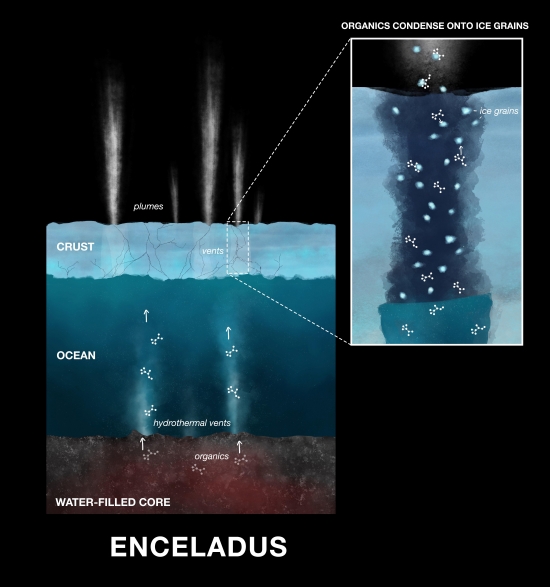
Image: This illustration shows how newly discovered organic compounds — the ingredients of amino acids — were detected by NASA’s Cassini spacecraft in the ice grains emitted from Saturn’s moon Enceladus. Powerful hydrothermal vents eject material from Enceladus’ core into the moon’s massive subsurface ocean. After mixing with the water, the material is released into space as water vapor and ice grains. Condensed onto the ice grains are nitrogen- and oxygen-bearing organic compounds. Credit: NASA/JPL-Caltech.
So let’s clarify the process. What the Cosmic Dust Analyzer is looking at appears to be organics that would have been dissolved in the ocean beneath Enceladus’ surface. These would have evaporated from the ocean and then condensed, freezing on ice grains inside fractures in the crust. Rising plumes would have accounted for these materials being blown into space.
We begin to get a window into what might be produced within the ocean, though the view is preliminary. In the excerpt below, note that the scientists classify various types of ice grains on Enceladus according to a taxonomy: Type 1 represents grains of almost pure water ice, Type 2 shows features consistent with grains containing significant amounts of organic material, and Type 3 is indicative of salt-rich water ice grains. The study homes in on Type 2:
It is highly likely that there are many more dissolved organic compounds in the Enceladean ocean than reported here… In this investigation of Type 2 grains, the initial constraints, in particular the choice of salt-poor spectra, favoured the identification of compounds with high vapour pressures. Despite the expected solubility of potential synthesized intermediate- or high-mass compounds, their low vapour pressures mean that they will not efficiently evaporate at the water surface and thus remain undetectable not only in the vapour, but also those Type 2 grains forming from it. Potential soluble biosignatures with higher masses might therefore be found in spectra from Type 3 grains, which are thought to form from oceanic spray (Postberg et al. 2009a, 2011). Finding and identifying such biosignatures will be the main goal of future work.
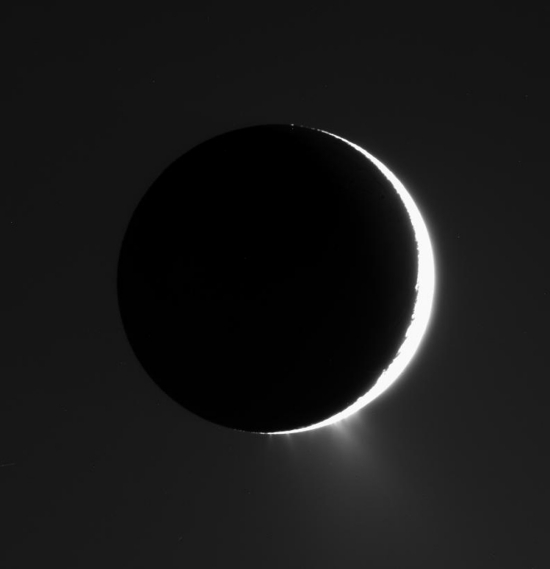
Image: With Enceladus nearly in front of the Sun from Cassini’s viewpoint, its icy jets become clearly visible against the background. The view here is roughly perpendicular to the direction of the linear “tiger stripe” fractures, or sulci, from which the jets emanate. The jets here provide the extra glow at the bottom of the moon. The general brightness of the sky around the moon is the diffuse glow of Saturn’s E ring, which is an end product of the jets’ material being spread into a torus, or doughnut shape, around Saturn. North on Enceladus (505 kilometers, or 314 miles across) is up and rotated 20 degrees to the left. Credit: NASA/JPL/Space Science Institute.
The researchers believe that similarities between the hydrothermal environment found on Enceladus and what we see on Earth prioritizes the exploration of the Saturnian moon for life. After all, we know of many places on our planet where life develops without sunlight, with the vents supplying the energy that fuels reactions leading to the production of amino acids. Despite the remarkable strides made by Cassini, its Cosmic Dust Analyzer was not, the authors say, designed for deep probing of this question. That makes high-resolution mass spectrometers a key component of any dedicated mission designed to explore the organic chemistry beneath the ice.
The paper is Khawaja et al., “Low-mass nitrogen-, oxygen-bearing, and aromatic compounds in Enceladean ice grains,” Monthly Notices of the Royal Astronomical Society Vol. 489, Issue 4 (November 2019), pp. 5231-5243 (full text).

Alan Boss: The Gas Giants We Have Yet to Find
The news of a gas giant of half Jupiter’s mass around a small red dwarf, GJ 3512 b, continues to resonate. It goes to what has become a well enshrined controversy among those who follow planet formation models. While core accretion is widely accepted as a way of building planets, gravitational instability has remained an option. We are not talking about replacing one model with another, but rather saying that there may be various roads to planet formation among the gas giants. In any case, GJ 3512 b makes a strong case that we have much to learn.
When I think about gravitational instability, I go back to the work of Alan Boss (Carnegie Institution for Science), as he has long investigated the concept. I learned about it from his papers and his subsequent book The Crowded Universe (Basic Books, 2009). Here’s how Boss describes it there:
Proponents of the top-down mechanism… envision clumps of gas and dust forming directly out of the planet-forming disk as a result of the self-gravity of the disk gas. The clumps would result from the intersections of random waves sloshing around the disk, waves that look much like the arms in spiral galaxies such as the Milky Way. When two spiral arms pass through each other, they momentarily merge to form a wave with their combined heights, just as waves do on the surface of an ocean. Such a rogue wave might rapidly lead to the formation of a clump massive enough to be self-gravitating, and so hold itself together against the forces trying to pull it apart. Once such a self-gravitating clump forms, the dust grains within the clumps settle down to the center of the protoplanet and form a core…
What emerges, then, is a solid core with gaseous envelope. In other words, this ‘disk instability’ model produces a planet that has the same structure as one derived from core accretion. What makes GJ 3512 b so interesting is that its position around a star as small as its host is hard to explain without a truly massive disk, and if that disk were to form, it would be unstable, and the gravitational instability model could come into play. The creator of this model, by the way, is Alastair Cameron (Harvard University), who spawned the notion in 1972. Other key players were Gerard Kuiper and Soviet scientist Victor Safronov, though it was Boss who revived the idea in 1997 and began developing computer models showing how it could occur.

Image: Simulation of the disk of gas and dust surrounding a young star. Credit: Alan Boss.
So what does Boss think of GJ 3512 b? As you might guess, he’s energized by the result:
My new models show that disk instability can form dense clumps at distances similar to those of the Solar System’s giant planets. The exoplanet census is still very much underway, and this work suggests that there are many more gas giants out there waiting to be counted.”
The work he is referring to is a new paper in press at The Astrophysical Journal that suggests there is a likelihood that gas giants in Jupiter-like orbits may be plentiful, with the inherent biases built into our observational techniques making them hard to find. As for how many of these may be formed from disk instability, Boss is computing various protoplanetary disk models to continue the investigation. As he notes in the new paper:
These models are intended to be first steps toward creating a hybrid model for exoplanet population synthesis, where a combination of core accretion and disk instability works in tandem to try to reproduce the exoplanet demographics emerging from numerous large surveys using ground-based Doppler spectroscopy and gravitational microlensing or space-based transit photometry (e.g., Kepler, TESS).
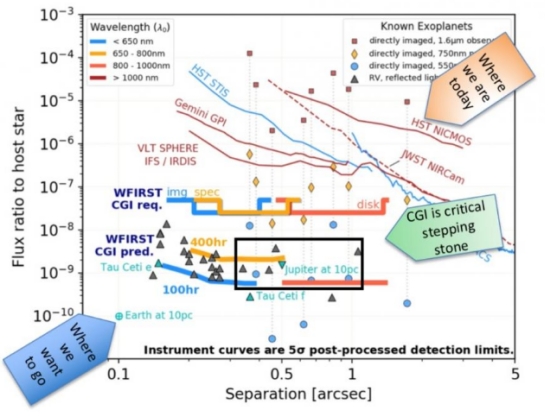
Image: The black box encapsulating Jupiter denotes the approximate region of exoplanet discovery space where Alan Boss’ new models of gas giant planet formation suggest significant numbers of exoplanets remain to be found by direct imaging surveys of nearby stars. NASA’s WFIRST mission, slated for launch in 2025, will test the technology for a coronagraph (CGI) that would be capable of detecting these putative exoplanets. Top Right: This simulation of the disk of gas and dust surrounding a young star shows dense clumps forming in the material. According to the proposed disk instability method of planet formation, they will contract and coalesce into a baby gas giant planet. Credit: Alan Boss.
We’re slowly eking out planets in wider orbits that are tricky for radial velocity, where their signals are more difficult to tease out than large planets close to their star, and also for transit work, because the transits would occur over an orbital period of five years or more. Boss continues to champion the concept that one size may not fit all when it comes to planet formation, with GJ 3512 b a striking case in point. Given a sufficiently massive protoplanetary disk, giant planets form in his models within 20 AU. Another targeted investigation for WFIRST will come out of all this when the mission launches some time in the next decade.
The paper is Boss, “The Effect of the Approach to Gas Disk Gravitational Instability on the Rapid Formation of Gas Giant Planets,” in press at The Astrophysical Journal (preprint).

An Unusual Gas Giant in a Red Dwarf System
The gas giant GJ 3512 b does not particularly stand out at first glance. About 30 light years from the Sun, it orbits its host star in 204 days, discovered by radial velocity methods by the CARMENES collaboration, which is all about finding planets around small stars. But look more deeply and you discover what makes this find provocative. GJ 3512 b turns out to be a gas giant with about half the mass of Jupiter, and small red dwarfs like this one aren’t supposed to host such worlds.
In fact, GJ 3512 b is at least an order of magnitude more massive than what we would expect from current theoretical models, making it an interesting test case for planet formation. Core accretion models assume the gradual agglomeration of material in a circumstellar disk, with small bodies banging into each other and growing over time until their gravity is sufficient to draw in an atmosphere from the surrounding gas. This gas giant defies the model, evidently having formed directly from the disk through gravitational collapse.

Image: Comparison of GJ 3512 to the Solar System and other nearby red-dwarf planetary systems. Planets around solar-mass stars can grow until they start accreting gas and become giant planets such as Jupiter, in a few millions of years. However, up to now astronomers suspected that, except for some rare exceptions like GJ 876, small stars such as Proxima, TRAPPIST-1, Teegardern’s star, and GJ 3512 were not able to form Jupiter mass planets. Credit: Guillem Anglada-Escude – IEEC/Science Wave, using SpaceEngine.org (Creative Commons Attribution 4.0 International; CC BY 4.0).
As for the host star, GJ 3512 has about 12 percent the mass of the Sun. The disks of gas and dust that surround such low mass stars are assumed to contain insufficient material to form planets like this. Consider: The Sun is 1050 times heavier than Jupiter, while the mass ratio between GJ 3512 and GJ 3512 b is 270. A much more massive debris disk would be needed to build this planet the conventional way, but if a disk of more than a tenth of the stellar mass is present, the star’s gravity cannot keep the disk stable. Gravitational collapse can then occur, as in star formation, but no disks this massive have been found around young red dwarf stars. Is this new exoplanet evidence that such disks can indeed form and be productive?
Things get even trickier when we consider other planets in the same system. At least one other planet is thought to exist, and the elliptical orbit of GJ 3512 b offers evidence for the gravitational effect of a possible third planet just as massive, one that may have been ejected. So now we have a small red star that would have needed to produce multiple massive planets, taking us well beyond current models. In a paper on this work from researchers at the Max Planck Institute for Astronomy, the University of Lund in Sweden and the University of Bern, the authors argue for gravitational disk collapse as the only viable method of formation.
“Until now, the only planets whose formation was compatible with disk instabilities were a handful of young, hot and very massive planets far away from their host stars,” says Hubert Klahr, who heads a working group on the theory of planet formation at the MPIA. “With GJ 3512 b, we now have an extraordinary candidate for a planet that could have emerged from the instability of a disk around a star with very little mass. This find prompts us to review our models.”

Image: Visualisation of the radial velocity (RV) measurement time-series and residuals obtained with CARMENES. Panel a illustrates how the RV of GJ 3512 (vertical axis) changes with time indicated in days since 8 December 2014, 12:00 p.m. UT (Universal Time, horizontal axis). HJD stands for Heliocentric Julian Day. Both the visual (blue symbols) and the infrared (red symbols) channels agree well. The black solid curve is the best orbital fit to the data. After subtracting the contribution of GJ 3512 b, panel b shows the residual, which indicates the presence of a long-term period hinting to a second planet. Panels c and d depict the residuals of the best overall orbital fit for the two CARMENES channels. Credit: Morales et al. (2019)/MPIA.
Considering pebble accretion vs. gravitational instability of the disk around this star, the scientists must look at a time early in formation when the disk was still massive relative to the star. The authors were unable to model an accretion process that would explain this system. But the competing model of gravitational instability results in a disk that is gravitationally unstable in a range of viscosities and surface densities at distances below 100 AU. From the paper:
The estimated masses of the fragments formed are less than that of Jupiter, consistent with the mass of GJ 3512 b. Except for unrealistically low values of a [disk viscosity], fragmentation of the disk occurs at radii of ?10 au, so the planets must have migrated a substantial distance from their formation locations to their present positions. This is possible given the large mass of the disk with respect to the planet, and is often seen in numerical simulations of disk fragmentation. For realistic viscosity a > 0.01, disk fragmentation typically occurs at radii of a few tens of au, and the total disk mass within this radius is ~30 MJ. Disks cannot extend too far beyond this fragmentation radius, because the total disk mass would become extremely large (up to 1 M? within 100 au). Thus, the planetary system around GJ 3512 favors the gravitational instability scenario as the formation channel for giant planets around very-low-mass stars.
If you’re looking for a comparison, consider TRAPPIST-1, a star with many of the characteristics of GJ 3512. Here we have seven planets with masses equal to or less than the mass of the Earth, and the ‘bottom up’ accretion model fits with observation. But GJ 3512 b all but forces us to look at models where the planet forms directly from gravitational collapse in the disk. We’d still like to know why GJ 3512 b hasn’t migrated closer to its star, an indication that the mysteries of this system may prove fodder for a great deal of future analysis.
The paper is Morales, et al. “A giant exoplanet orbiting a very low-mass star challenges planet formation models”, Science 27 September 2019 (abstract).

Looking Back, and Ahead
Centauri Dreams was launched as a website in 2004 for a specific reason. I was wrapping up my book of the same name and wanted to build a simple database of news stories related to the angles on interstellar flight I had covered in the book. I intended the site to be used for no other purpose, and didn’t turn on the comments function until a year after the site went live. My plans were for a second edition of the book, but I began to realize as the website grew that to avoid instant obsolescence, the Web was my best friend. This site, then, began serving as a de facto second edition and I’ve kept it running now for 15 years.
Sometimes I’m asked how long I plan to keep the site going, and the answer is simply that I plan to be here for years to come. I have no thoughts about closing down Centauri Dreams. But as my work in the space community has grown, I’ve also become involved in various other aerospace efforts to which I’ve contributed, and right now I’m in the midst of a report on a particular kind of interstellar mission that demands a lot of transcription of talks, extensive note-taking along the way, and drawing together a lot of different viewpoints and research.
In practical terms, while Centauri Dreams isn’t going away, this also means that my posts are occasionally going to become sporadic, as they will be in the next few weeks. I’ll post when I can, but I have to devote the bulk of my attention to this particular project, which leaves little time for anything else in my workday. So bear with me, please. The comments are still live and I’ll do moderation on them at least twice a day. Feel free to comment when you have the urge. Once I get the current effort wrapped up, things should return to something like normalcy.

2I/Borisov: Naming the Interstellar Visitor
Congratulations to Gennady Borisov, the Crimean amateur who discovered the object now officially designated as 2I/Borisov (with a 0.65-metre telescope he built himself!). That ‘I’ in the designation points to the object’s interstellar origins, and picks up the nomenclature used with the first interstellar object in our system, 1I/’Oumuamua. We’ve examined thousands of comets over the years but have found none with an orbit as hyperbolic as 2I/Borisov. That means that while the comet’s trajectory is being affected by the Sun, it’s not going to be captured by it.
What’s ahead: 2I/Borisov reaches perihelion on 7 December 2019, at which point it will be 2 astronomical units from the Sun and also 2 AU from Earth. It reaches its brightest levels in the southern sky in December and January and then heads back out toward the interstellar deep. So far, it appears that 2I/Borisov is a few kilometers in diameter, and we’ve also learned — via the Gran Telescopio Canarias (Canary Islands) — that its spectrum resembles typical cometary nuclei. The new interstellar visitor appears to be more straightforward than 1I/’Oumuamua.
But considering that 1I/’Oumuamua appeared a scant two years before 2I/Borisov, the inference is clear that such objects may be fairly numerous. Keep in mind that new instrumentation about to come online will expand our catalog, allowing us to investigate exoplanetary systems in ways beyond radial velocity and transits, through the spectra of objects within our own system.
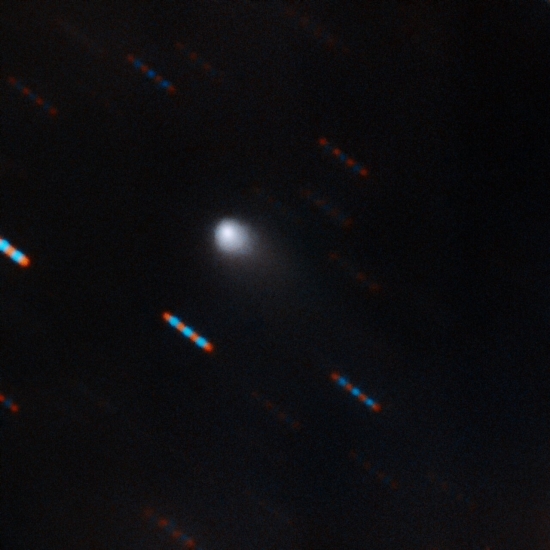
Image: A comet from beyond our Solar System, as imaged by the Gemini Observatory. The image of the newly discovered object, named 2I/Borisov, was obtained on the night of 9-10 September 2019 using the Gemini Multi-Object Spectrograph on the Gemini North Telescope on Hawaii’s Mauna Kea. Credit: Gemini Observatory/NSF/AURA.
There is little doubt about 2I/Borisov’s cometary nature, given that observations have shown a condensed coma and a short tail. The IAU’s decision to give it a designation as an interstellar object follows the computation of its orbit by the IAU Minor Planet Center, with confirmation of the hyperbolic orbit from JPL’s Solar System Dynamics Group. Now we wait to learn how often to expect such objects and how much information we will be able to tease out of them.


